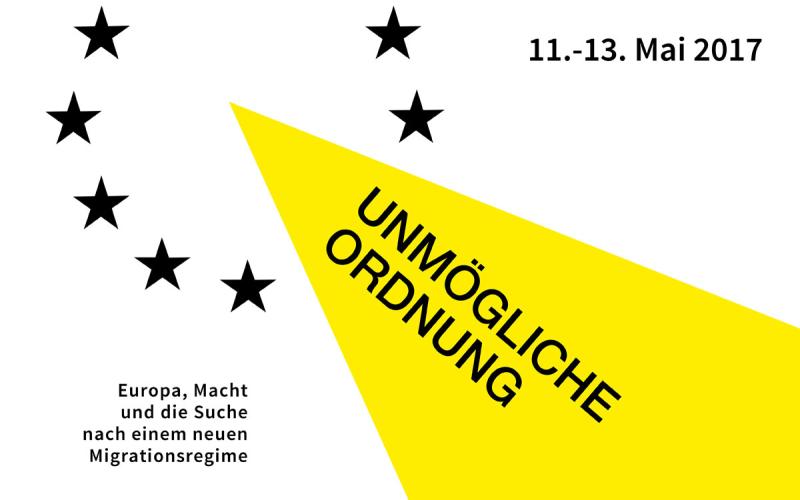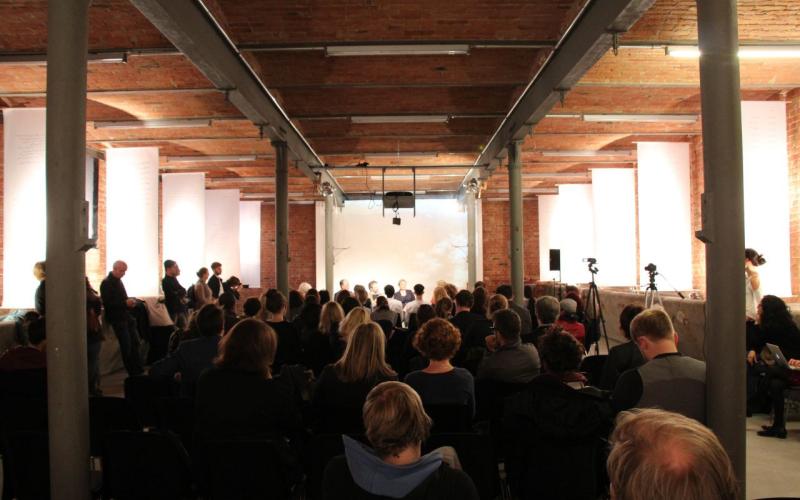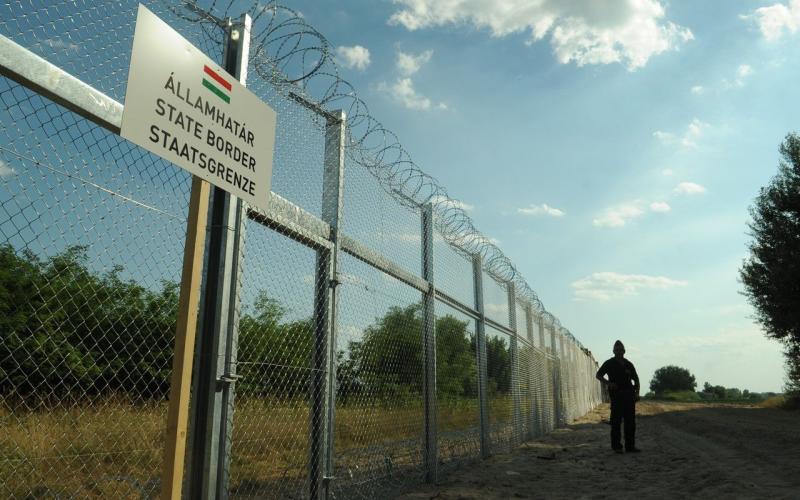As an introduction, Prof. Catherine Gousseff, the director of the Centre Marc Bloch, Berlin and a historian of the twentieth century forced migrations within and from Eastern Europe highlighted some of the panel's key questions: Most importantly she emphasized that not only institutions but also refugees were important participants in a forming European identity. Yet, the varieties of migration to and from Europe as well as of (inter-) national institutions and politics responding to these migration flows lead to the impression that searching for a European identity were an endless process. The political mechanisms in respect to these migration flows, however, are mostly concerned with border control and migration regulation and mostly frame migration as a security problem. Recent events in Europe like Brexit and the French presidential election campaign reaffirm the impression that Europe has indeed not yet found its final identity. She continued to welcome the speakers of the first panel. Dr. Olaf Kleist, a political scientist with a special focus on refugee and asylum policy in Germany and Europe, forced migration, political participation and sovereignty at the Institute for Migration Research and Intercultural Studies (IMIS) at Osnabrück University presented the first paper. He was followed by Dr. Angela Siebold, a contemporary historian and research assistant at the Goethe University Frankfurt. Her main research fields are the history of migration, minorities and alterity in European societies of the 19th and 20th centuries. Prof. Bashshar Haydar, a philosopher at the American University of Beirut (AUB), completed the panel. His research concentrates on moral, political philosophy and aesthetics and he is a frequent contributor to public debates on current social and political conditions in the Middle East.
Olaf Kleist’s speech’s main argument is that the so called “refugee crisis” does not only challenge the European migration regime but also exposes a lack of appropriate methodical instruments to deal with refugees on a long-term basis. While pro-European actors keep repeating that refugees should be regarded as an opportunity for Europe, it remains unclear why and to what extent. On the other hand, the influx of people, which is now perceived as a “crisis”, has been an integral part of human history. Nevertheless, each period of mass migration has produced something new. Kleist argued that the recent “crisis” provokes three major changes in the European and global order.
After the Cold War era, global refugee work was managed by the global North financing the global South for the admission and harboring of refugees. In this way, the global North delegated its responsibility to deal with the refugees to the global South, ignoring the important aspects of integration. Despite UNHCR's efforts to abandon this strategy it persisted and caused a humanitarian crisis of aid to refugees. Having ignored the continuously growing number of refugees until autumn 2015, the EU reacted to the pressure by taking two steps: First by a enforced closure of its borders and second by once more externalizing the responsibility for refugees to Turkey to maintain the old order.
Hence, the first major change is the increased emphasis on border security and control. This strategy involves two main problems: Searching for further collective selection mechanisms often undermines individual protection rights. Moreover, by externalizing borders and control outside of EU ground the union loses its political independence, as the deal with Turkey demonstrates. Secondly, since states’ commitment to human rights on a global level is more or less voluntary, states are in control of shaping refugee aid. As a result, rights of refugees are globalized to a certain degree (e.g. through subsidiary protection). At the same time these rights tend to be limited to a minimal human rights standard. Lastly, one must realize that the civil society is one of the key actors in the integration of refugees. As can be observed in the example of Canada, a bottom-up approach seems to be the most fruitful way of effective integration. Mr. Kleist concludes that these conflicting trends can only be overcome by close cooperation between state and civil actors.
Dr. Angela Siebold analysed the Schengen area has historically shaped European identity.
After World War II and in the shadow of the 'Iron Curtain', West-Europeans developed and manifested their own collective identities. It was in 1985, when a group of central European states spear-headed by Western Germany signed the first Schengen treaty. It aimed to tighten the economic relations between European countries. In its first version, the Schengen area had been defined without the territory of the German Democratic Republic. Hence, necessary renegotiations after the collapse of the Berlin Wall delayed the process of implementation until 1995. Other participating states doubted that Germany were able to control its Eastern external borders of the Schengen area. They feared for mass migration from the East, mainly Poland, due to the collapse of the 'Iron Curtain'. This was the first time Schengen was problematized in political and public discourse under the aspect of migration.
The withdrawal of internal borders within the Schengen area made it necessary to strengthen its external borders. This created an European identity which sharply distinguishes between an “inside” and an “outside” of Schengen. As a consequence, Poland as a prospective EU-member felt growing pressure to control its borders to Ukraine despite it was not yet feel integrated in the borderless Schengen area.
Schengen was also used to legitimize the establishing of other security mechanisms like the Schengen Information System (SiS), Frontex and buffer zones which further deepened the perception of an inside and an outside among European states and societies.
On the one hand, Angela Siebold described the creation period of Schengen as a typical project of “old Europe”, which gave birth to a new European identity and perception of freedom by opening the internal borders. On the other hand, the existence of a borderless area inspired anxieties about migration flows from the “outside”. As a consequence, during the 1990s Schengen reproduced the former East/West-orientation of the Iron Curtain along the Schengen borders. Mrs. Siebold underlined that not only borders are dynamic and have changed over time, but also narratives about “inside” and “outside” were deeply influenced by historical processes.
The last speaker of the first Panel was Mr. Bashshar Haydar from Beirut University. He put himself in the role of an “EU-outsider” and compared the political and public discussions about integration between Lebanon and Germany.
Even though, he described, Lebanon is an economically weak country whose lack of agreement in government is risking a political power vacuum, the country hosts about 1.5 million Syrian refugees, the globally highest percentage of refugees per capita. As an introduction he asked rhetorically, why Germany, a country with much bigger economic and political potential than Lebanon, is so anxious of the arriving Syrian refugees and so reluctant to integrate them. Even though he admitted that Syrian refugees in Lebanon suffer from economic distress and labor abuse and no access to political and legal rights protection, he pointed out that they find a place in society. Perhaps, Bashshar Haydar went on, they are not perceived as “outsiders” because they share very similar values with the Lebanese. However, Syrians are heading to Europe aiming to improve their living conditions.
In Germany, their situation is quite the opposite: They receive better legal protection and, for time being, are allowed to stay, but are far from calling themselves integrated in society. Many Germans deny that the integration of the Turkish population was a success story, mostly due to a clash of values. So how should Syrians make the quasi-impossible possible and reach a level of integration that meets the Germans’ requirements? Haydar argued that from his perspective, the Turkish are a success story of integration, as they vote (if they can) and work like every other German would do. Hence, it is not a question of integration but of identity. Integration needs time, and it needs to be understood that the Syrian immigration is not an economic one. Looking back on Germany’s history of integration, people should focus on small successes that have been achieved and start from here to further improve integration strategies. He concludes that little can be done in changing political borders, but if people start to reflect what they expect from integration instead of denying it, it will be much easier to turn the Syrian immigration and integration process into German a success story. Letting them articulate themselves and letting them be an integral part of German society will relativize the feeling of a 'crisis', which to Mr. Haydar is a mere “fake crisis”.
While Kleist and Siebold highlighted internal conflicts in the “crisis”-like situations, contrastingly Mr. Haydar focussed on the chances and positive aspects of it. Each of the panelists developed a different notion of “identity”. Kleist sought to understand how the actual situation will change involved actors (politicians, global institutions, refugees, hosting civil society) not only in their actions but also in the way they perceive themselves. Siebold drew on on historical dynamics and pointed out that Schengen has led to a new understanding of a “European identity” by reshaping the discourse of inside and outside. As an effect it introduced a new understanding of freedom within Europe. At the same time, however, external borders were intensified and a new “othering”-process replaced the long lasting Cold War's East/West-divide, a division now manifested at the Schengen borders. Haydar finally concentrated on civil society, and how the perception of the host society's identity influences the integration process of refugees. By pointing out that integration is a long process, he recommended to focus on small successes and to learn from experiences.
As a whole, the first panel presented a strong input rich in diverse perspectives to rethink what the meaning of “European identity” could be, how migration influenced European history and societies throughout the past. At the same time, it demonstrated that a possible “European identity” is far from a defined entity. It remained an open question how it could help to overcome the mentioned problems – or if rather enforces the issues by strengthening the divided between a perceived inside and outside. Searching for a shared identity, as the title of the whole conference suggests, is indeed a never-ending process, which will continuously provoke changes and opportunities at the same time.
Zitation
Freya Kuhn, Migration and European Identity. Panel I , in: Zeitgeschichte-online, , URL: https://zeitgeschichte-online.de/themen/migration-and-european-identity



